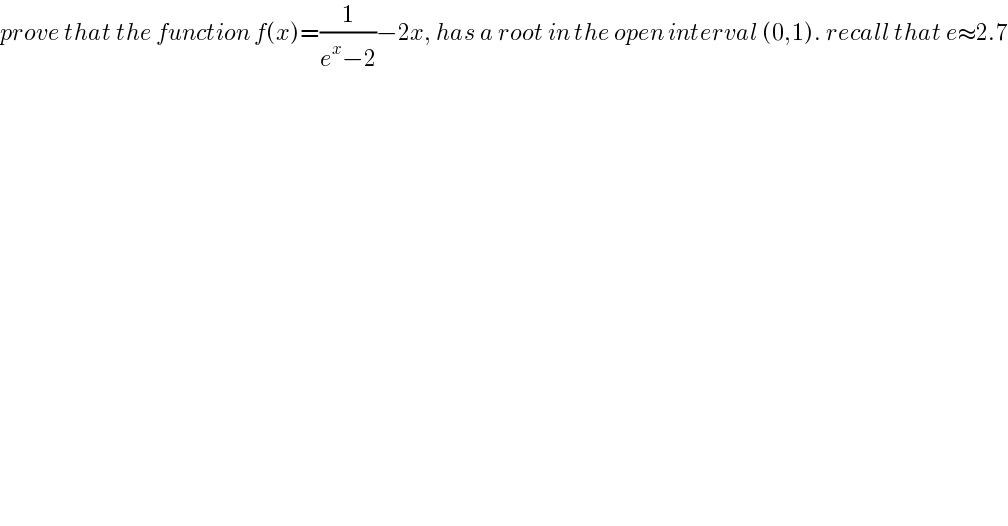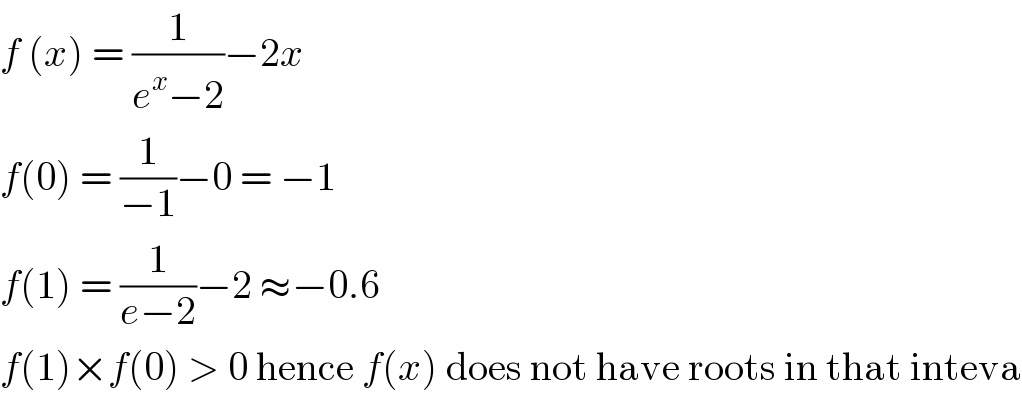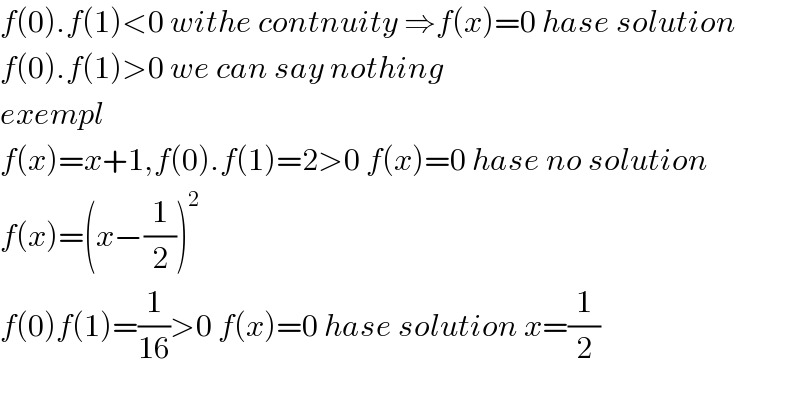Question Number 125815 by Tanuidesire last updated on 14/Dec/20

$${prove}\:{that}\:{the}\:{function}\:{f}\left({x}\right)=\frac{\mathrm{1}}{{e}^{{x}} −\mathrm{2}}−\mathrm{2}{x},\:{has}\:{a}\:{root}\:{in}\:{the}\:{open}\:{interval}\:\left(\mathrm{0},\mathrm{1}\right).\:{recall}\:{that}\:{e}\approx\mathrm{2}.\mathrm{7} \\ $$
Answered by physicstutes last updated on 14/Dec/20

$${f}\:\left({x}\right)\:=\:\frac{\mathrm{1}}{{e}^{{x}} −\mathrm{2}}−\mathrm{2}{x} \\ $$$${f}\left(\mathrm{0}\right)\:=\:\frac{\mathrm{1}}{−\mathrm{1}}−\mathrm{0}\:=\:−\mathrm{1} \\ $$$${f}\left(\mathrm{1}\right)\:=\:\frac{\mathrm{1}}{{e}−\mathrm{2}}−\mathrm{2}\:\approx−\mathrm{0}.\mathrm{6} \\ $$$${f}\left(\mathrm{1}\right)×{f}\left(\mathrm{0}\right)\:>\:\mathrm{0}\:\mathrm{hence}\:{f}\left({x}\right)\:\mathrm{does}\:\mathrm{not}\:\mathrm{have}\:\mathrm{roots}\:\mathrm{in}\:\mathrm{that}\:\mathrm{inteva} \\ $$
Commented by Tanuidesire last updated on 14/Dec/20

$${thanks}! \\ $$
Commented by mindispower last updated on 14/Dec/20

$${f}\left(\mathrm{0}\right).{f}\left(\mathrm{1}\right)<\mathrm{0}\:{withe}\:{contnuity}\:\Rightarrow{f}\left({x}\right)=\mathrm{0}\:{hase}\:{solution} \\ $$$${f}\left(\mathrm{0}\right).{f}\left(\mathrm{1}\right)>\mathrm{0}\:{we}\:{can}\:{say}\:{nothing} \\ $$$${exempl} \\ $$$${f}\left({x}\right)={x}+\mathrm{1},{f}\left(\mathrm{0}\right).{f}\left(\mathrm{1}\right)=\mathrm{2}>\mathrm{0}\:{f}\left({x}\right)=\mathrm{0}\:{hase}\:{no}\:{solution} \\ $$$${f}\left({x}\right)=\left({x}−\frac{\mathrm{1}}{\mathrm{2}}\right)^{\mathrm{2}} \\ $$$${f}\left(\mathrm{0}\right){f}\left(\mathrm{1}\right)=\frac{\mathrm{1}}{\mathrm{16}}>\mathrm{0}\:{f}\left({x}\right)=\mathrm{0}\:{hase}\:{solution}\:{x}=\frac{\mathrm{1}}{\mathrm{2}} \\ $$$$ \\ $$
